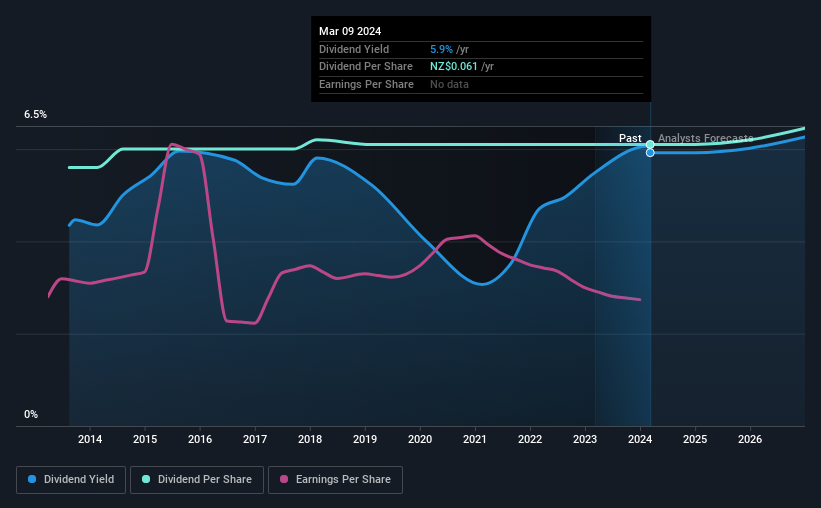Stock Analysis
- New Zealand
- /
- Capital Markets
- /
- NZSE:NZX
Don't Race Out To Buy NZX Limited (NZSE:NZX) Just Because It's Going Ex-Dividend

NZX Limited (NZSE:NZX) is about to trade ex-dividend in the next 4 days. The ex-dividend date is usually set to be one business day before the record date which is the cut-off date on which you must be present on the company's books as a shareholder in order to receive the dividend. The ex-dividend date is of consequence because whenever a stock is bought or sold, the trade takes at least two business day to settle. In other words, investors can purchase NZX's shares before the 14th of March in order to be eligible for the dividend, which will be paid on the 28th of March.
The company's next dividend payment will be NZ$0.0364705 per share, and in the last 12 months, the company paid a total of NZ$0.061 per share. Based on the last year's worth of payments, NZX stock has a trailing yield of around 5.9% on the current share price of NZ$1.03. If you buy this business for its dividend, you should have an idea of whether NZX's dividend is reliable and sustainable. So we need to check whether the dividend payments are covered, and if earnings are growing.
Check out our latest analysis for NZX
Dividends are usually paid out of company profits, so if a company pays out more than it earned then its dividend is usually at greater risk of being cut. NZX paid out 145% of profit in the past year, which we think is typically not sustainable unless there are mitigating characteristics such as unusually strong cash flow or a large cash balance.
Generally, the higher a company's payout ratio, the more the dividend is at risk of being reduced.
Click here to see the company's payout ratio, plus analyst estimates of its future dividends.

Have Earnings And Dividends Been Growing?
Companies with falling earnings are riskier for dividend shareholders. If business enters a downturn and the dividend is cut, the company could see its value fall precipitously. So we're not too excited that NZX's earnings are down 3.8% a year over the past five years.
The main way most investors will assess a company's dividend prospects is by checking the historical rate of dividend growth. NZX has delivered an average of 0.9% per year annual increase in its dividend, based on the past 10 years of dividend payments.
To Sum It Up
Has NZX got what it takes to maintain its dividend payments? Not only are earnings per share shrinking, but NZX is paying out a disconcertingly high percentage of its profit as dividends. It's not that we hate the business, but we feel that these characeristics are not desirable for investors seeking a reliable dividend stock to own for the long term. This is not an overtly appealing combination of characteristics, and we're just not that interested in this company's dividend.
With that being said, if you're still considering NZX as an investment, you'll find it beneficial to know what risks this stock is facing. Our analysis shows 1 warning sign for NZX and you should be aware of this before buying any shares.
If you're in the market for strong dividend payers, we recommend checking our selection of top dividend stocks.
Valuation is complex, but we're helping make it simple.
Find out whether NZX is potentially over or undervalued by checking out our comprehensive analysis, which includes fair value estimates, risks and warnings, dividends, insider transactions and financial health.
View the Free AnalysisHave feedback on this article? Concerned about the content? Get in touch with us directly. Alternatively, email editorial-team (at) simplywallst.com.
This article by Simply Wall St is general in nature. We provide commentary based on historical data and analyst forecasts only using an unbiased methodology and our articles are not intended to be financial advice. It does not constitute a recommendation to buy or sell any stock, and does not take account of your objectives, or your financial situation. We aim to bring you long-term focused analysis driven by fundamental data. Note that our analysis may not factor in the latest price-sensitive company announcements or qualitative material. Simply Wall St has no position in any stocks mentioned.
About NZSE:NZX
Excellent balance sheet second-rate dividend payer.

